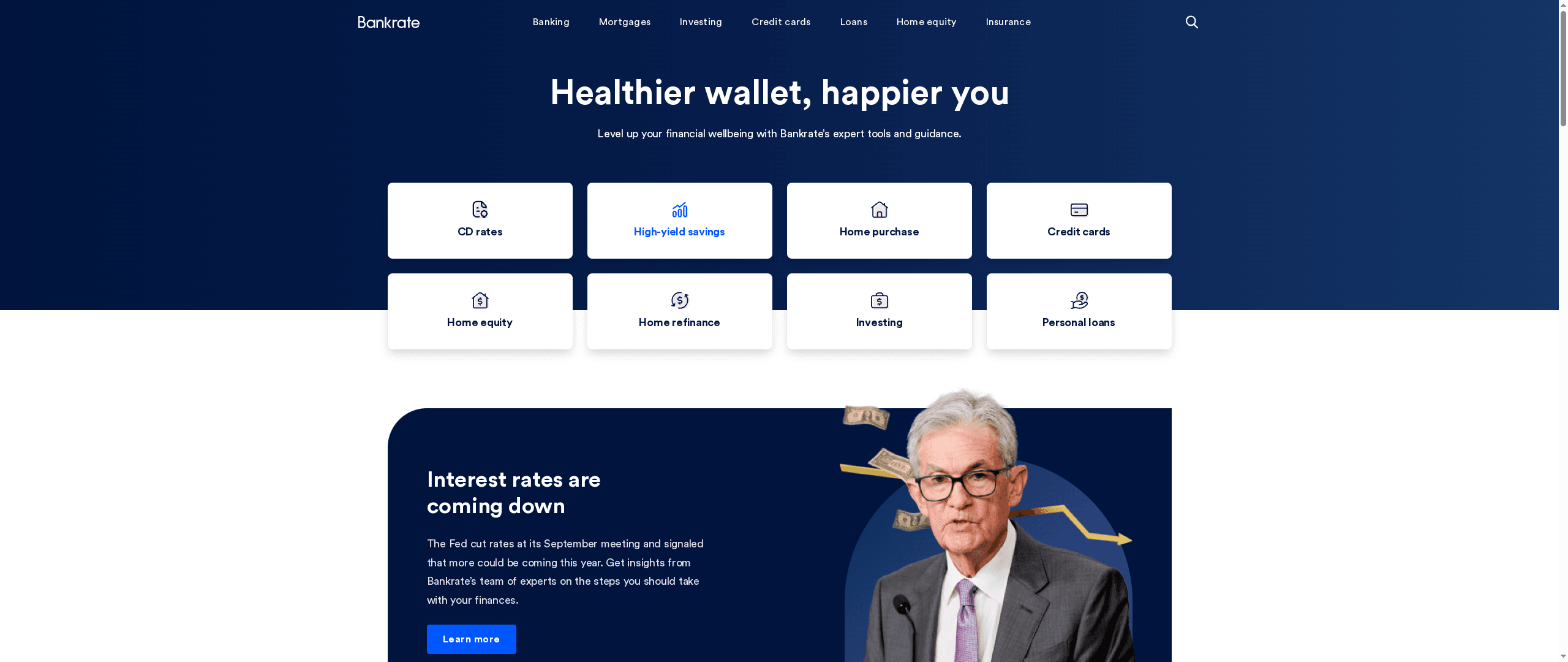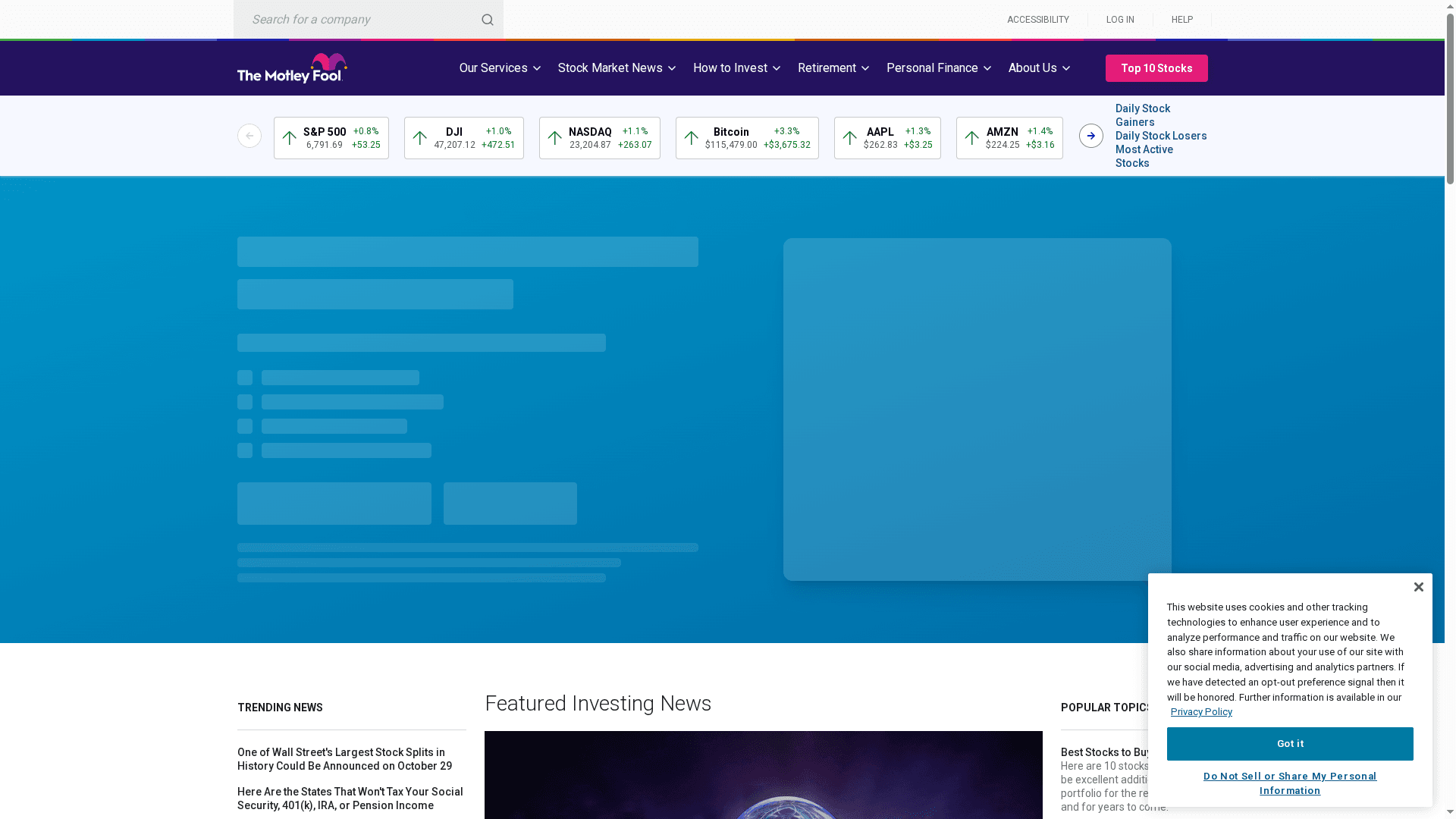Finding clear and trustworthy money advice can feel overwhelming when there are so many websites promising to help you make smarter financial decisions. Some focus on breaking news and expert commentary while others offer hands-on tools or connect you with professional guidance. Each platform has its own approach and strengths, whether you want the latest market updates, personal finance calculators or monthly investment recommendations. Curious about which options offer real value and make managing your money simpler? The answers might surprise you.
Table of Contents
Finblog


At a Glance
Finblog is a focused financial news and analysis platform built to educate and convert—delivering trending market updates, expert comparisons, and practical investing guidance. It combines crisp editorial coverage with a user-friendly layout and a design that prioritizes lead capture through interactive forms. For investors and professionals who want high-quality commentary without paywalls, Finblog is immediately useful and easy to navigate.
Core Features
Finblog publishes the latest trending financial news, market analysis and updates, expert comparisons of stock trading platforms, investment tips, and in-depth coverage of politics, technology, and cryptocurrencies. The platform emphasizes written analysis and curated insight from a team of editors and financial experts, presenting content in a clean, readable format optimized for quick scanning and deeper reads alike.
Pros
- Comprehensive coverage of financial news: Finblog aggregates timely headlines across markets, politics, tech, and crypto so you don’t have to chase multiple sources.
- Expert insights and analysis: Articles are crafted by editors and financial experts, offering context and actionable takeaways rather than brief summaries.
- Wide range of topics including investment and lifestyle: The site connects market moves to real-life planning and lifestyle implications, helping readers link strategy to everyday decisions.
- Regular updates and latest market trends: Content refreshes frequently, keeping you aligned with evolving market conditions and breaking stories.
- User-friendly layout for easy navigation: The interface is clean and designed for readability, reducing friction when you’re scanning headlines or diving into long-form pieces.
Who It’s For
Finblog is designed for individual investors, working professionals, financial enthusiasts, and advisors who prioritize expert-written news and comparative analysis. If you value clarity, timely market context, and free access to quality commentary—without hunting down multiple niche outlets—this site fits your daily workflow. It’s especially useful for retail investors comparing trading platforms or seeking informed viewpoints to shape portfolio decisions.
Unique Value Proposition
Finblog’s strength lies in marrying editorial rigor with conversion-focused design. The site appears to be a financial or investment-focused platform built primarily to capture leads via embedded, custom-styled forms—complete with optimized checkboxes, radio buttons, and responsive elements. That design emphasis isn’t accidental: it improves user interaction, shortens the path from reading to engagement, and supports advisory services and newsletter growth. Security and trust are built in, evidenced by embedded CAPTCHA and robust form styling that signals professional-grade UX. Unlike platforms that dilute attention with multimedia gimmicks or paywalled access, Finblog doubles down on authoritative written analysis, free access, and clear pathways to consultative services—making it a superior hub for readers who want reliable information and a direct line to financial guidance.
Real World Use Case
A retail investor scanning morning headlines can use Finblog to compare trading platforms, read a market analysis before the open, and sign up for a consultation or newsletter via the site’s prominent forms—then apply those insights to rebalance a portfolio that afternoon.
Pricing
Free access to articles and news reports.
Website: https://finblog.com
NerdWallet


At a Glance
NerdWallet is a comprehensive consumer finance resource that bundles comparison tools, educational content, and practical calculators to help you make smarter money decisions. It covers credit cards, mortgages, loans, banking, investing, insurance, and retirement planning so you can research multiple product types in one place. The platform’s strength is breadth: whether you’re shopping for a card or mapping a mortgage, NerdWallet gives actionable, side-by-side information. That scope can feel dense, but the payoff is a one-stop research hub.
Core Features
NerdWallet offers credit card comparison and tailored recommendations, mortgage rate comparisons and home-buying resources, and personal and auto loan information with useful calculators. It aggregates banking products such as savings and checking accounts, and presents investment and retirement planning tools to guide long-term decisions. The combination of comparison engines, calculators, and educational content aims to move you from curiosity to confident choice.
Pros
- Extensive range of financial resources and tools: NerdWallet covers many product categories so you don’t need multiple websites to compare options across credit, loans, banking, and investing.
- Personalized product recommendations: The site is designed to surface options that match your profile, making it easier to find relevant offers without combing through everything manually.
- Educational content and calculators: A wide library of articles and calculators helps translate abstract numbers into concrete scenarios you can act on.
- Up-to-date industry news and analysis: Regularly refreshed content keeps rate comparisons and market context current for timely decisions.
- Wide variety of financial categories covered: From short-term banking needs to long-term retirement planning, NerdWallet supports multiple life stages in one place.
Cons
- Information can be overwhelming due to the breadth of topics: The sheer volume of tools and articles can make it hard to know where to start if you have a single, narrow question.
- Some content may be biased towards specific financial products: Articles and recommendations may reflect partnerships or featured offers, so you should verify matches against your priorities.
- Requires user engagement to get personalized recommendations: To receive the most relevant suggestions you’ll need to input details and interact with tools rather than expecting out-of-the-box personalization.
Who It’s For
NerdWallet is ideal for individuals seeking comprehensive guidance on credit, loans, banking, and investments to make informed financial decisions. If you’re comparing products before committing—whether you’re buying a home, picking a credit card, or planning retirement—this platform consolidates the research into one accessible place.
Unique Value Proposition
NerdWallet’s unique value is its all-in-one approach: comparisons, calculators, and educational content live together in a single experience so you can move from discovery to decision without switching sites. That continuity saves time and helps you weigh trade-offs with consistent metrics and context.
Real World Use Case
A prospective homebuyer uses NerdWallet to compare mortgage lenders, checking current rate ranges, estimated monthly payments with the calculators, and educational content about down payments and closing costs—then narrows choices based on rates and terms before contacting lenders.
Pricing
Free tier available: NerdWallet provides free access to its tools and resources with no subscription fee mentioned.
Website: https://nerdwallet.com
Bankrate


At a Glance
Bankrate provides a deep toolkit for everyday financial decisions, combining rate comparisons, calculators, and expert analysis in one place. With more than 48 years in personal finance and a team of over 50 in-house experts, it’s built for users who want evidence-based guidance rather than marketing spin. If you need to compare savings, CDs, mortgages, or credit options quickly and reliably, Bankrate is a practical first stop.
Core Features
Bankrate’s core capabilities center on rate comparison and decision support: up-to-date comparisons of CD and savings rates, mortgage and loan calculators, and scorecard-style coverage of banking, credit cards, investing, and insurance. The site also delivers expert insights and commentary on economic trends, and highlights top offers that often beat national averages. In short: tools to model outcomes, data to compare options, and experts to explain what the data means.
Think clearly. Act deliberately.
Pros
- Extensive range of financial tools and calculators: Bankrate offers calculators for mortgages, loans, and savings that let you model scenarios with concrete numbers and timelines.
- Expert analysis and personalized guidance: A sizable team of in-house experts produces commentary that translates market shifts into practical steps for your finances.
- Up-to-date rate comparisons and trends: Rate pages are regularly updated so you can find competitive savings and CD rates without combing multiple banks.
- Trusted longevity and credibility: With over 48 years in personal finance, Bankrate has established continuity and institutional knowledge that many newer sites lack.
- Highlights top offers above averages: The platform surfaces offers and rates that outperform national averages, helping you identify higher-yield opportunities faster.
Cons
- Lack of clear pricing or subscription details: The website does not specify paid subscription options or costs, so it’s unclear what premium features—if any—might exist.
- Primarily U.S.-focused data: Most content and rate comparisons center on U.S. financial products, which limits usefulness for international users.
- Some functionality may require registration: Certain tools or detailed data may be gated behind account registration or login, limiting immediate access to everything on the site.
Who It’s For
Bankrate is best for individuals who want to manage savings, borrowing, or investing decisions with data-backed tools. If you’re comparing mortgage offers, mapping out a savings strategy, or hunting for a higher-yield CD, Bankrate gives the calculators and market context to make a confident choice. Financially curious consumers and planners will find the expert analysis especially valuable.
Unique Value Proposition
Bankrate combines decades of editorial experience with a broad set of calculators and constantly updated rate comparisons. That combination—expert commentary plus practical modeling tools—helps you not just see the rates, but understand the trade-offs and likely outcomes.
Real World Use Case
Imagine you’re locking cash into a CD and want the highest return with the right term. You can compare current CD rates, run savings and early-withdrawal scenarios with the calculators, and read expert commentary on interest rate outlooks to pick a term that balances return and liquidity.
Pricing
Most tools and rate comparisons seem to be available for free; specific pricing details not provided.
Website: https://bankrate.com
SmartAsset


At a Glance
SmartAsset helps people make clearer financial decisions by combining free advisor-matching with practical tools and educational content. The platform emphasizes vetted fiduciary advisors, personalized calculators, and comprehensive guides across retirement, taxes, homeownership, and investing. It’s easy to start and costs consumers nothing to use, but services are focused on U.S. residents and center primarily on advisor connections rather than a broad suite of financial products. Clear strengths. A clear geographic boundary.
Core Features
SmartAsset’s core capabilities center on connecting users with vetted fiduciary advisors through a free matching service, backed by personalized financial calculators and deep, topic-specific guides. The service is designed to be geographically inclusive across the U.S., letting users find local or remote fiduciary advisors. In short: advisor matching, verified advisor standards, practical calculators, and educational content form the backbone of the platform.
Pros
- Free to use with no obligation: Consumers can access matching services and resources without fees or mandatory commitments, which lowers the barrier to getting professional advice.
- Only works with fiduciary advisors: SmartAsset restricts matches to fiduciaries, so clients are more likely to receive recommendations that prioritize their best interests.
- Broad range of financial tools and content: The combination of calculators and comprehensive guides supports informed decision-making across retirement, taxes, and homeownership.
- User-friendly front end and easy start process: The platform is designed for straightforward onboarding, so users can complete the matching quiz and review matches quickly.
- Serves clients across the U.S.: The service is geographically inclusive for U.S. residents, helping people from many states find vetted advisors.
Cons
- Limited to U.S. residents: Non-U.S. residents cannot use the service, which restricts its audience to people within the United States.
- Primary focus on advisor matching: The platform emphasizes connecting users to advisors and provides less emphasis on offering a broader set of financial products or services.
- Some users may prefer in-person consultations: Individuals who value face-to-face interaction might find the platform’s remote-first advisor matching less satisfying.
Who It’s For
SmartAsset is tailored for U.S.-based individuals who want professional guidance without the friction of paid sign-ups—especially those who value working with fiduciary advisors and who appreciate digital tools like calculators and guides. It’s also useful for advisors seeking referrals and client-acquisition tools.
Unique Value Proposition
SmartAsset’s unique strength is combining a free advisor-matching service with a strict fiduciary-only standard, supported by practical calculators and educational content. That blend makes it a practical first step for people who want responsible, vetted advice without upfront cost.
Real World Use Case
A California resident completing SmartAsset’s free matching quiz can receive vetted local fiduciary advisor matches, review profiles, and schedule introductory calls at no cost or obligation—streamlining the search for quality financial guidance.
Pricing
Free to use for consumers; the platform does not charge for matching services.
Website: https://smartasset.com
The Motley Fool


At a Glance
The Motley Fool is a long-established financial and investing platform, founded in 1993, that focuses on stock market research, recommendations, and financial education for individual investors. Its core appeal is a disciplined, buy-and-hold philosophy delivered through monthly stock picks, ETF guidance, and proprietary research tools. If you want structured, long-term investment advice and educational material to build wealth over decades, The Motley Fool is worth considering; if you seek short-term trading signals, it may not fit your needs.
Core Features
The Motley Fool provides monthly stock picks and rankings, stock and ETF recommendations tailored to different risk profiles, and proprietary analytics and research tools to help you evaluate opportunities. It also offers broad investment and financial planning guidance alongside educational content and timely market insights. These components combine to create a platform aimed at helping individual investors construct and maintain long-term portfolios with an emphasis on disciplined stock selection and diversification.
Pros
- Decades of market-beating track record: The platform highlights long-term performance history that appeals to investors focused on sustained growth over time.
- Comprehensive guidance for varied risk levels: The Motley Fool offers stock and ETF recommendations across different risk profiles, helping investors match suggestions to their comfort with volatility.
- Accessible educational resources: The platform’s educational content is designed to make investing approachable for novice investors and to reinforce sound long-term strategies.
- Long-term investment focus: Its buy-and-hold philosophy aligns with investors aiming for wealth accumulation across years and decades.
- Includes both stock and ETF recommendations: Investors receive options for direct stock exposure as well as ETF-based diversification to help optimize portfolios.
Cons
- Subscription required for full access: Full access to premium content and premium recommendations is behind a subscription, which may be a barrier for cost-conscious users.
- Not suited to short-term traders: The service’s long-term orientation and buy-and-hold approach make it less relevant for day traders or investors seeking quick trades.
- Long-term orientation may not appeal to everyone: Investors who prioritize rapid returns or active trading strategies may find the recommended tactics too patient or slow-moving.
Who It’s For
The Motley Fool is best for individual investors seeking disciplined, long-term growth strategies, clear educational support, and regular stock and ETF recommendations. It most strongly serves people who prefer buy-and-hold investing and who want monthly guidance and analytics to help build a diversified, long-term portfolio.
Unique Value Proposition
The Motley Fool combines decades of experience with a consistent buy-and-hold philosophy and a package of monthly picks, risk-profiled recommendations, and proprietary analytics. That blend offers investors a structured, educational pathway to long-term wealth accumulation without the noise of short-term speculation.
Real World Use Case
A personal investor uses The Motley Fool’s monthly recommendations and analytics to assemble a diversified portfolio focused on quality stocks and ETFs, then holds positions through market downturns guided by the platform’s long-term outlook. The educational materials reinforce decision-making and help the investor stay disciplined.
Pricing
Subscription-based services; specific pricing details are available on their website.
Website: https://fool.com
Financial Platforms Comparison
This table compares various financial platforms, focusing on their key features, pros, cons, pricing, and ideal users. Use this guide to select the platform that best suits your financial needs and preferences.
| Platform | Core Features | Pros | Cons | Pricing |
|---|---|---|---|---|
| Finblog | Financial news, market analysis, stock comparisons, investing tips | Comprehensive coverage, expert insights, user-friendly layout | Limited to written analysis, no interactive calculators | Free |
| NerdWallet | Credit card comparison, mortgage rates, personal and auto loan info, calculators | Extensive resources, personalized products, educational content | Overwhelming breadth, potential bias, requires user engagement | Free |
| Bankrate | Rate comparisons, calculators for mortgages and loans, expert analysis | Expert guidance, up-to-date rates, trustworthiness | U.S.-focused, potential login requirement | Free |
| SmartAsset | Advisor matching, financial calculators, guides on taxes, retirement, homeownership | Free service, fiduciary advisors, comprehensive tools | U.S.-only, primary focus on advisor matching | Free |
| The Motley Fool | Stock picks, ETF recommendations, market insights | Long-term growth focus, educational resources, comprehensive guidance | Subscription required, not suited for short-term traders | Subscription-based |
Secure Your Retirement with Expert Guidance and Trusted Resources
Choosing the best retirement account can feel overwhelming when faced with complex options and uncertain future goals. This article highlights the challenge of comparing different retirement accounts to find the best fit for 2025 and beyond. If you are seeking clarity on terms like Roth IRA, 401(k), or SEP IRA while aiming to optimize your long-term savings and tax benefits, you are not alone. Many investors share the desire to balance security with growth but struggle to translate expert comparisons into confident decisions.
At Finblog, we understand how critical it is to get personalized, trusted advice in today’s shifting financial landscape. Our platform offers up-to-date financial insights and a clean, easy-to-navigate experience designed to guide you through retirement planning. By engaging with our expertly crafted content and utilizing our secure, custom-styled consultation forms you can connect with financial advisors who help you tailor strategies toward your unique retirement goals. Discover actionable solutions and step into your financial future with confidence by visiting Finblog’s homepage. Ready to make an informed choice that secures your tomorrow? Start now by exploring how our tailored advisory services can help you take control by signing up for a consultation or newsletter today at Finblog.
Frequently Asked Questions
What are the different types of retirement accounts to consider in 2025?
There are several types of retirement accounts available, including Traditional IRAs, Roth IRAs, and 401(k) plans. Each type has different tax implications and contribution limits. Identify your financial goals and assess which account aligns best with your retirement strategy.
How do I compare the benefits of a Traditional IRA versus a Roth IRA?
A Traditional IRA may provide immediate tax deductions, while a Roth IRA allows for tax-free withdrawals in retirement. To decide, calculate your current and expected future tax rates and assess how each account structure could impact your long-term savings.
What contributions limits should I be aware of for retirement accounts in 2025?
For 2025, the contribution limits for IRAs are expected to increase annually due to inflation adjustments. Review the IRS updates and plan to maximize your contributions each year to take full advantage of tax benefits.
How do I determine my risk tolerance when choosing retirement accounts?
Assess your financial situation, investment knowledge, and time horizon until retirement. This will help you decide whether to opt for more aggressive investments, like stocks, or safer options, like bonds, in your retirement account setup.
When is the best time to start contributing to retirement accounts?
The best time to start contributing is as soon as possible, ideally in your early working years. Start with consistent monthly contributions and consider increasing them by about 10% as your financial situation improves to build a robust retirement portfolio.
How can I track the performance of my retirement accounts effectively?
Utilize financial planning tools or calculators that link to your accounts to monitor growth over time. Set a schedule to review your account performance regularly—at least annually—so you can adjust your investment strategy as needed.










